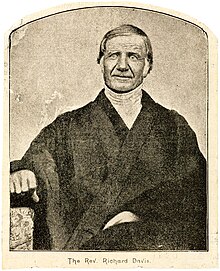Richard Davis (missionary)
Richard Davis | |
|---|---|
 | |
| Born | January 18, 1790 Dorset, England |
| Died | May 28, 1863 (aged 73) |
| Known for | Meteorology, missionising |
Reverend Richard Davis (1790–1863) was a New Zealand meteorologist, missionary and farmer. He made weather recordings in the northern North Island from 1839 to 1844, and 1849 to 1851, making them the oldest continuous land-based recordings in New Zealand. In 2019 they were inscribed into UNESCO's Memory of the World Aotearoa New Zealand Ngā Mahara o te Ao documentary heritage register. Davis was born in Dorset, England.
Career
[edit]Davis was a missionary. The Church Mission Society sent Davis and his wife and six children to Northland in 1824, from Dorset. He then started a farm at Waimate North[1] in 1830[2][3] and grew seeds from England, including both fruits and vegetables. Understanding the climate was required to grow these plants.[1] He was ordained on Trinity Sunday 1843.[3][4][5] He was appointed to Kaikohe from 1845 to 1854, then he returned to Te Waimate Mission from 1854 to 1863.[6]
Davis made weather records in two journals, one from 1839 to 1844 at Te Waimate Mission and Kaikohe, and the other from 1849 to 1851.[7][8] The gap occurred when Davis was ordained a deacon and had established Kaikohe Mission Station.[1] The recordings were of temperature and barometric pressure, with qualitative comments on wind speed and direction, extreme weather and cloud cover.[8][9] The temperature was recorded twice a day, at 9am and noon, and the air pressure was also measured at noon.[1] There are two records of snowfall which is a rare event in Auckland and Northland, having only occurred since European settlement six times as of 2016. An entry from 30 July 1849 reads: "Hail storms. This morning the southern hills and Poutahi covered with snow".[1]
They are believed to be the oldest continuous land-based recordings in New Zealand,[7] possibly making Davis the country's first meteorologist. The Royal Engineers had begun making regular land-based observations in Auckland in the 1850s.[1] The observations have been used by the National Institute of Water and Atmospheric Research (NIWA) to study the weather in that region of the country as well as climate change.[7] In 2019 Davis's weather records were inscribed into UNESCO's Memory of the World Aotearoa New Zealand Ngā Mahara o te Ao documentary heritage register.[7][8] They are kept at the Auckland Council Libraries.[7]
He had also sent several hundred letters to England which include observations of geography, social interactions between European settlers and Māori, and astronomy, including comets and the southern lights.[10]
Personal life
[edit]Davis was born on 18 January 1790 in Dorset, England. He died on 28 May 1863. His friend Reverend John Coleman wrote a memoir about him.[10]
Notes
[edit]- ^ a b c d e f "Dear diary: A pioneer of meteorology". NIWA. 30 June 2016. Retrieved 15 January 2025.
- ^ Bedggood, W.E. (1971). Brief History of St John Baptist Church Te Waimate. News, Kaikohe.
- ^ a b Rogers, Lawrence M. (1973). Te Wiremu: A Biography of Henry Williams. Pegasus Press.
- ^ "The Church Missionary Gleaner, November 1844". Spiritual Awakening at Kaikohi, New Zealand — Need of Earnest Prayer. Adam Matthew Digital. Retrieved 13 October 2015.
- ^ "The Church Missionary Gleaner, June 1851". Heke. Adam Matthew Digital. Retrieved 18 October 2015.
- ^ Bedggood, W.E. (1971). Brief History of St John Baptist Church Te Waimate. News, Kaikohe.
- ^ a b c d e "Two Auckland Council Libraries heritage collections receive UNESCO heritage recognition". Our Auckland. Auckland Council. 18 February 2020. Retrieved 15 January 2025.
- ^ a b c "Richard Davis Meteorological Records 1839-1851". UNESCO Memory Of The World. Retrieved 15 January 2025.
- ^ Lorrey & Chappell 2016, p. 553.
- ^ a b Lorrey & Chappell 2016, p. 554.
References
[edit]- Lorrey, Andrew M.; Chappell, Petra R. (1 March 2016). "The "dirty weather" diaries of Reverend Richard Davis: insights about early colonial-era meteorology and climate variability for northern New Zealand, 1839–1851". Climate of the Past. 12 (2): 553–573. Bibcode:2016CliPa..12..553L. doi:10.5194/cp-12-553-2016. ISSN 1814-9332.
Further reading
[edit]- Davis, Rev. Richard (1865). Coleman, John Noble (ed.). A Memoir of the Rev. Richard Davis: for Thirty-Nine Years a Missionary in New Zealand. London: James Nisbet & Co. Retrieved 20 December 2020.
External links
[edit]- Register of thermometer and barometer from 1849 to 1851
